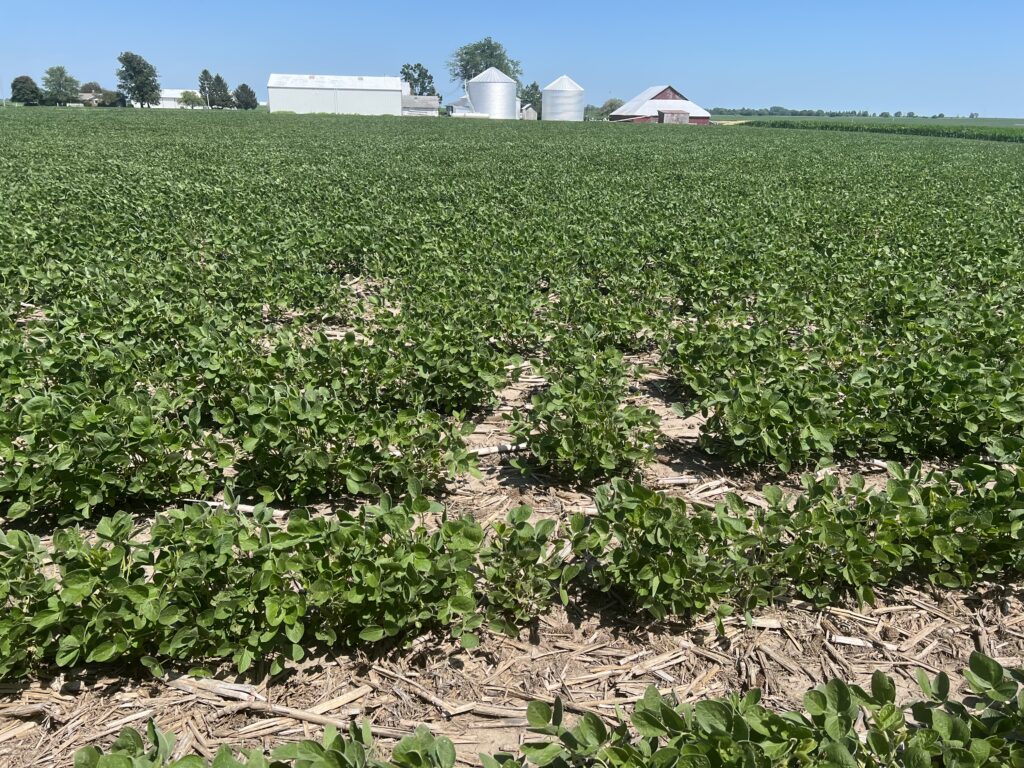After a heck of a planting season with several different planting windows and some replant, we have finally reached mid-season when we may be spraying a field or finally getting another chance to evaluate the stand. After some heavy rains over the last several weeks, I have started to get some calls asking for help to try to figure out why they might have some sparse soybean stands in certain fields. If it wasn’t hail, slugs, herbicide, or human error, what else could we blame?

Poor stand in fields was due to a certain variety that had poor seed quality. (Photo submitted by Stephanie Porter, CCA, Illinois Soybean Association)
Unfortunately when the seed arrived, it was described as having very poor seed quality, which could have contributed to stand issues. However, a closer look revealed scattered dead plants throughout fields of a certain soybean variety.

Scattered dead plants were found within gaps of field that consisted of a certain soybean variety that had poor seed quality. (Photo submitted by Stephanie Porter, CCA, Illinois Soybean Association)
Upon closer inspection, there were some plants starting to collapse and show characteristic signs of Phytophthora root rot. These soybean signs would be a top that has curled over and a dark area or canker at the base of the stem. As always, you can send plants to a diagnostic clinic to get disease confirmation.

A soybean plant with the characteristic signs of Phytophthora root rot (curled over top and dark area or canker at the base of the plant). Photo submitted by Stephanie Porter, CCA, Illinois Soybean Association
At this point, there is no rescue treatment for Phytophthora root rot, but we can start to plan for next year. In an earlier blog post, You Think Your Soy Has the Blight: Now What?, I encouraged farmers to keep track of the disease history of the field and if possible, improve drainage, reduce compaction, and avoid poor seed quality as all of these things could encourage seedling blight such as Phytophthora.
The next step would be to look up your soybean variety in your company’s seed guide. There, the company will provide agronomic details for each soybean variety. In this case, this soybean variety was rated as “very good” on Phytophthora root rot. It is more important to know the type of genetic resistance or Rps (Resistance to Phytophthora sojae) genes which are race specific that are SUPPOSED to offer complete resistance to a specific race of Phytophthora sojae. Sometimes you can find this information in your seed company’s guide, or you may have to ask. In this situation, this soybean variety consisted of Rps1k multi-race Phytophthora root rot resistance.

Example of agronomic details for one soybean variety located within a seed guide. (Graphic submitted by Stephanie Porter, CCA, Illinois Soybean Association)
So, if the seed guide says that this soybean variety is rated “very good” on Phytophthora root rot and consists of Rps1k multi-race Phytophthora root rot resistance, then why are soybean plants still becoming infected and dying due to Phytophthora?
Unfortunately, according to research done according to this article, A global-temporal analysis of Phytophthora sojae resistance-gene efficacy, there has been a loss of efficacy of specific Rps genes utilized for disease management. Simply put, the most widely available Phytophthora stem and root rot resistance genes Rps1a, Rps1c, Rps1k currently only protect against 11 percent, 26 percent, and 15 percent of P. sojae individuals in the United States. You can read more in this recent blog post, Soybean Phytophthora Stem and Root Rot Resistance Genes Have become Less Effective.
If you are finding Phytophthora root rot in your fields, it is recommended that you try to find a soybean variety that consists of Rps-gene (Rps3a) along with high levels of partial resistance (field tolerance). If this is not possible, I would encourage your seed company to provide soybean varieties with Rps3a as soon as possible to effectively manage Phytophthora stem and root rot into the future.


 and then
and then